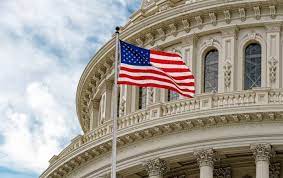


The United States debt ceiling is a parliamentary limit that decides how much debt the Treasury Department may incur. In 1939, Congress gave the Treasury the right to issue and manage debt though it restricted the amount of the issuance. The limit applies including the roughly $24.5 trillion of debt held by the public and the roughly $6.9 trillion the government owes itself as a result of borrowing from various government accounts. Since the end of World War II, Congress and the President have modified the debt ceiling more than 100 times. According to the latest December 2021 bill (117th Congress Public Law 73), the limit has been increased to $31.381 trillion (almost $31.4 trillion).
Since 2009, America’s national debt has nearly tripled, with annual federal deficits averaging close to $1 trillion since 2001. Over the years, it has increased for various reasons, including tax cuts under Presidents Bush and Trump, wars in Iraq and Afghanistan, expenditure related to the COVID-19 pandemic. Taking consideration of all such factors, the national debt is likely to be double the United States’ GDP by 2051.
In 2023, the debt limit has reached its limit on 19 Jan’23, whereas the Treasury Secretary Janet Yellen has highlighted in a letter dated 13 January 2023, that though the use of the “extraordinary measures” enables the government to meet its obligations, but for only a limited amount of time, and this is not a sustainable solution. She suggested that Congress should act in a timely manner to enhance or suspend the debt limit, to avoid “irreparable harm’ to the U.S. economy as well as global financial stability. In the past, during 2011 debt-ceiling crisis, a major credit rating agency downgraded the U.S. country rating, global stocks stooped, and emerging market (EM) countries’ bond prices declined.
Who holds U.S. Debt?
The U.S. debt in dollars is mostly held by the (a) Governments (b) Central Banks (c) Companies (d) Individual Investors. As of January 2023, foreign countries own $7.4 trillion in Treasuries (or roughly 24% of total US debt) including public and intragovernmental debt. According to the “USA Facts”, central banks and other government entities have owned 50-75% of foreign-owned debt over the past two decades, while independent investors and companies held the rest. While Japan and China held almost 50% of all foreign-owned US debt between 2004 and 2006. However, this has declined over time, and as of 2022 they controlled approximately 25% of foreign-owned debt.
It may be noted that the United States dollar (used heavily in international trade) is considered to be the world’s reserve currency for a variety of reasons, including how large the American economy is, America’s geopolitical strength, the dollar’s relative stability, and the market for U.S. debt. As a result, foreign creditors (including China, Japan, and the United Kingdom) are large markets for the currency. This makes it easier for the U.S. government to finance the national debt, via being charged lower interest rates for borrowing money. However, Ruchir Sharma has pointed in an article titled as “Why Dollar’s Losing Its Shine” (Times of India, 25th April 2023), that “ a critical barometer of dollar strength is its status as the currency foreign central banks prefer to hold in reserve, and this has been declining faster than many people realise, particularly since the launch of Russia sanctions. By one measure, the dollar share of central bank reserves is down to 47% from 73% two decades ago, with nearly a third of that decline coming since the start of 2022.” Another article titled as “America’s Debt-Ceiling Disaster” by Filippo Gori, published in the FOREIGN AFFAIRS (24 April,2023), has highlighted that “a severe debt-ceiling crisis could cause much of the world to stop trusting the currency (the US dollar), accelerating the end of its international supremacy and with it, these privileges. It would be a spectacular debacle-weakening the U.S. economy and undermining the United States’ international standing-of the country’s own creation.” It may further be noted from the IMF Currency Composition of Official Foreign Exchange Reserves (IMF,COFER) that during December2010-June2011, the share of allocated currency reserves in U.S. dollars declined from 62% to nearly 60.8%, when due to similar reason, one CRA downgraded U.S. According to a Trendlyne report, the market share of the US dollar in the world’s forex reserves fell to nearly 58.4% in Q4-2022 from 61.85% in Q1-2020, even though it is still the dominant reserve currency. In 2011, the U.S. narrowly avoided default due to a last-minute debt ceiling negotiation and the country’s credit rating was downgraded as a result. According to a Moody’s Report “Going Down the Debt Limit Rabbit Hole” (March 2023), the “X Date” (the day when the federal government can no longer meet all its obligations in full and on time) will likely arrive no earlier than the third quarter of 2023, the “X Date” is likely to be 18th August2023.
House Republicans passed Debt limit Bill
On 26th April 2023, House Republicans passed legislation that would raise the government’s legal debt ceiling by $1.5 trillion in exchange for steep spending restrictions (a strategic victory for the speaker Kevin McCarthy as the Republicans has raise the debt limit). The House Republican majority expects to manoeuvre Biden with its plan to roll back federal spending to fiscal 2022 levels and cap future spending increases at 1% over the next decade, among other changes. The House bill would raise Washington’s borrowing ability by $1.5 trillion or until March 31, whichever comes first, raising the spectre of another round of negotiations during the 2024 presidential campaign. The Democrats concern are in adverse to the Republicans, for instance, the overnight alterations eliminated a provision that would have ended a tax credit for biofuels that was part of Biden’s climate change initiatives in the 2022 Inflation Reduction Act. Democrats are also not happy about the likely expenditure reduction on programs including healthcare for the poor and an array of other programs including law enforcement and airport security operations. This might enforce the fear of the looming recession as most leading indicators including the treasury yield curve (the gap between long and short-term treasury yields) indication recession beginning later this year. This would be further reinforced due to the era of monetary tightening by the Fed.
Implications for the Economy of a binding debt limit
As a Brookings article titled as “How worried should we be if the debt ceiling isn’t lifted?” (24 April 2023) by Wendy Edelberg and Louise Sheiner has highlighted that the economic impact would be highly uncertain as the impact would depend largely on the expectations of financial market participants, businesses, and households. Under normal circumstances, economic agents’ perception is that there should be some way out, and a country like U.S. cannot default. However, many unprecedented events have happened in the past that shocked the World, e.g., the “Global Financial Crisis in 2008”, in recent times, large banks like Credit Suisse, Silicon Valley Bank (SVB), Signature banks have defaulted. In fact, it seems that since 2020, i.e., from Covid Year, we are living in interesting times, followed by the geopolitical issue, inflation challenge, weak market sentiments, probable recessionary fears. Even the threat of default can create huge financial market instability as well as humongous borrowing costs, and eventually a turmoil in the global economic order. According to the estimate by the Government Accountability Office (GAO), the 2011 debt ceiling standoff increased borrowing costs by a total of $1.3 billion in the Fiscal year 2011 and the 2013 debt limit stalemate led to added costs over a one-year period of between $38 million and more than $70 million. Further, a Moody’s Analytics report (“Going Down the Debt Limit Rabbit Hole”, March 2023) has highlighted that in a scenario of large spending cuts, especially the elimination of the nondefense discretionary spending and the medical program, there could be a downturn with 2.6 million jobs at stake pushing the unemployment to a peak of nearly at 6%.


Vipin Malik is Chairman at Infomerics Ratings. Sankhanath Bandyopadhyay is an economist at Infomerics Ratings.